Expert Tips for Cleaning Your Wool Throw Rug
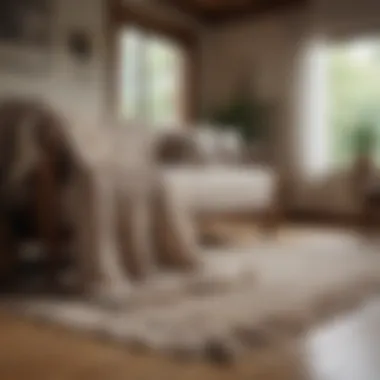

Intro
Cleaning a wool throw rug may seem straightforward, but it requires special attention. Wool is a natural fiber that can be delicate and adaptable, yet it is also prone to dirt and stains. Proper maintenance is essential for preserving both the aesthetic appeal and the functionality of your rug. This guide will walk you through the tools, techniques, and best practices for keeping a wool throw rug in top condition.
Understanding the materials used in wool rugs is the first step. Wool is often valued for its softness and durability. However, specific cleaning methods must be followed to avoid damaging the fibers. Common cleaning challenges include dirt buildup, stains from spills, and fading from sunlight exposure. Knowing the right approaches to tackle these issues can greatly improve the longevity of your rug.
In the following sections, we will detail both spot cleaning and deep cleaning methods. We will also highlight some preventive measures that can help minimize the need for extensive cleaning in the first place. Ultimately, the goal is to equip you with the knowledge to maintain your wool throw rug effectively.
Understanding Wool Throw Rugs
Wool throw rugs are not just decorative pieces; they play an integral role in enhancing the ambiance of a living space while offering functional benefits. Recognizing the composition, benefits, and typical uses of these rugs helps in making informed decisions about care and maintenance. Understanding these aspects is necessary for proper cleaning and upkeep, ensuring the longevity and beauty of your investment.
Composition of Wool Rugs
Wool rugs are crafted from the fibers of sheep, which provide a natural and eco-friendly option for home decor. The primary source is sheep wool, typically from breeds such as Merino or Romney. These fibers are spun into yarn, which is then woven or tufted into rugs. The unique structure of wool fibers consists of scales, contributing to its resilience and texture. This makes wool rugs comfortable underfoot and a good insulator.
Additionally, the natural oils found in wool, called lanolin, help repel dirt and stains. This means that while these rugs require regular cleaning, they also possess innate properties that mitigate the buildup of grime. Understanding the composition is crucial. It enables rug owners to adopt suitable cleaning methods that preserve these advantageous qualities.
Benefits of Wool Fibers
Wool fibers bring a multitude of benefits that justify the popularity of wool throw rugs. One significant advantage is durability. Wool is inherently strong, providing resilience against wear and tear. This makes wool rugs an excellent choice for high-traffic areas. Moreover, the elasticity of wool allows it to bounce back after compression, maintaining its appearance over time.
Another benefit is the warmth wool provides. It naturally regulates temperature, which can help create a cozy atmosphere during cold weather. Additionally, wool is effective at absorbing moisture without feeling damp. This property contributes to a healthier indoor environment as it helps in regulating humidity levels and can reduce allergens. The charming texture and variety of designs available ensure that these rugs can complement various interior design styles.
Common Uses of Wool Throw Rugs
Wool throw rugs can be utilized in numerous settings within a home. Common locations include living rooms, bedrooms, and hallways. Their versatility allows them to serve as focal points or subdued accents in decor. These rugs can also be used in entryways, helping to capture dirt and moisture before it spreads to other areas of the house.
Other popular uses extend to outdoor spaces as well. When treated for outdoor use, wool rugs can withstand the elements, providing a stylish option for patios and balconies. In short, the common uses of wool throw rugs indicate their adaptability, enhancing both aesthetic and functional aspects of various interiors.
Importance of Regular Cleaning
Regular cleaning of wool throw rugs is essential for maintaining their quality and appearance over time. A wool rug, like any other textile, can accumulate dirt, dust, and allergens. Cleaning is not merely about aesthetics; it also plays a critical role in prolonging the life of the rug, preserving its texture and color, and creating a healthier environment in your home.
Enhancing Longevity
A well-maintained wool throw rug can last for many years, even decades, if cared for properly. Regular cleaning prevents dirt from embedding into the fibers, which, if left unchecked, can lead to permanent damage. Dust and grime act like abrasives, causing wear and tear on the delicate wool fibers. Without regular vacuuming and cleaning, the rug’s lifespan can be significantly shortened.
Additionally, proper care, involving both spot cleaning and deep cleaning methods, ensures that the rug retains its original shape and texture. Setting a cleaning schedule, whether weekly or monthly, can greatly enhance the longevity of your rug.
Maintaining Aesthetic Appeal
The visual appeal of your wool throw rug directly influences the overall aesthetic of your living space. Regular cleaning keeps the colors vibrant and the texture plush. Wool fibers can lose their luster if they are allowed to accumulate dirt and dust. A clean rug provides a focal point in the room and can complement your decor rather than detracting from it.
A quick vacuuming can often revitalize its appearance by removing surface debris. Sometimes, spot cleaning is necessary when mishaps occur. A simple stain can easily draw the eye, impacting how the entire room is perceived. Therefore, it is crucial to tend to your rug with care and attention.
Preventing Allergens
Wool throw rugs can harbor allergens such as dust mites, pet dander, and pollen. Regular cleaning helps mitigate these factors, contributing to a healthier indoor environment. This is particularly important for individuals who suffer from allergies or respiratory issues. Wool itself is naturally resistant to dirt and stains, but it can still attract allergens over time.
Vacuuming effectively removes these particles, minimizing exposure. Regular cleaning not only protects your rug but helps maintain air quality in your home. A clean rug contributes to a cleaner living space, providing peace of mind and comfort.
"An ounce of prevention is worth a pound of cure."
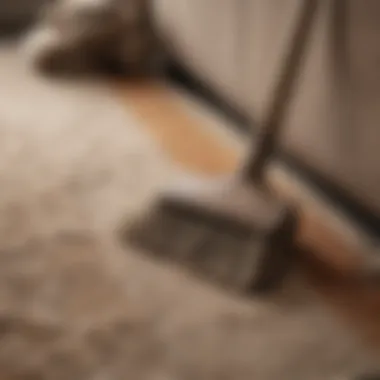
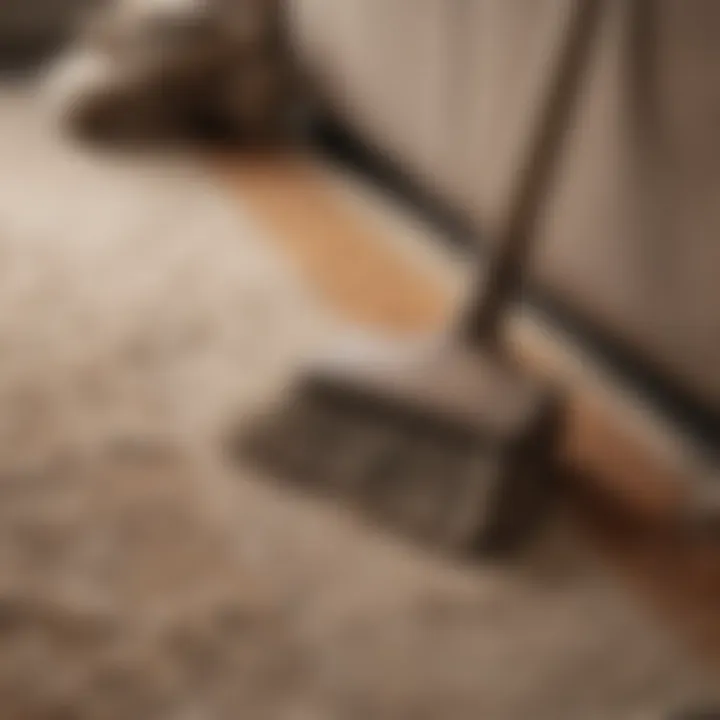
Essential Cleaning Tools and Supplies
Cleaning a wool throw rug effectively requires more than just good intentions. The right tools and supplies play a pivotal role in maintaining the integrity and beauty of these rugs. Using inappropriate items can lead to damage, while the proper selection ensures that the cleaning process is both efficient and gentle. Every wool throw rug owner should invest in specific tools to enhance their cleaning routines and prolong the rugs’ lifespan.
Vacuum Cleaner
A vacuum cleaner is fundamental for the upkeep of wool throw rugs. Regular vacuuming removes dust, dirt, and debris that accumulate on the surface. For wool fibers, it is crucial to use a vacuum with a suction control feature. Too high a suction power can pull fibers loose, leading to premature wear. A vacuum with a brush attachment is beneficial. It works effectively against dirt while being gentle on the wool fibers. Additionally, vacuuming should be done at least once a week to prevent grime build-up.
Soft Brush
In conjunction with a vacuum, a soft brush is an invaluable tool. A natural bristle brush is ideal for wool rugs, as it prevents snagging while allowing for a gentle cleaning. Brushing helps lift dirt trapped deep within fibers and refreshes the rug’s appearance. It is advisable to brush the rug in the direction of the fibers. This method prevents breakage and gives the rug a cozy, fluffy look. Include this in your cleaning routine to maintain both aesthetics and fiber health.
Wool-Safe Detergent
When it comes time for deeper cleaning, using a wool-safe detergent is essential. Many commercial cleaners can strip the natural oils from wool, causing dullness and damage. A detergent specifically formulated for wool preserves its natural characteristics while effectively removing stains and odors. When choosing a detergent, check for labels that specify its suitability for wool. Using too much can lead to residue build-up, which can attract more dirt. Always follow the recommended dilution instructions to ensure you’re using it correctly.
Stain Remover
Stains are inevitable in homes where wool throw rugs are in use. Therefore, having a reliable stain remover on hand is crucial. Effective stain removers can target specific stains without harming the wool fibers. When selecting a product, look for a pH-balanced formula that is safe for wool. Always perform a spot test in an inconspicuous area before full application to avoid any adverse reactions.
In summary, utilizing the right tools and cleaning supplies is essential for the continued beauty and longevity of wool throw rugs. With proper care, you can prevent common issues and keep your rug looking vibrant. Consider these items as necessary investments for maintaining your rugs.
Remember: Proper care begins with the right tools.
Spot Cleaning Techniques
Spot cleaning is essential for maintaining the appearance and integrity of your wool throw rug. It allows for the immediate removal of stains and spills, preventing them from setting in and causing permanent damage. Effective spot cleaning can extend the lifespan of your rug, ensuring it remains a focal point in your decor rather than an eyesore.
Identifying Stains
The first step in successful spot cleaning is identifying the type of stain you're dealing with. Not all stains are equal; some are water-soluble, while others may require special attention. Common sources of stains include food, beverages, mud, and pet accidents. It helps to take note of the stain's age and nature, as older stains tend to set harder, making them more challenging to remove. Assessing your rug's color and pattern can also guide you in choosing the right cleaning method, as certain approaches might affect more vibrant or intricate designs.
Applying Stain Remover
Once you identify the stain, it is time to apply an appropriate stain remover. When selecting a product, ensure it is wool-safe and designed specifically for the fabric, such as wool detergents or specialized stain removers. For best results, apply the stain remover product lightly onto the affected area using a clean, white cloth. This is critical as colored or patterned cloths can sometimes transfer dyes to the rug. Remember to always follow the manufacturer's instructions on the stain remover to avoid causing further damage.
Blotting Methods
After applying the stain remover, the next step is blotting. This technique involves gently pressing a clean, white cloth or paper towel onto the stained area. Avoid rubbing, as this can damage the fibers of the wool or spread the stain further. Instead, work from the outside of the stain towards the center. The goal is to absorb as much of the stain and cleaning solution as possible. Repeat this process as necessary until no more residue transfers to the cloth.
Drying the Affected Area
Once the stain is successfully treated, drying the area is crucial to prevent any mold or mildew growth. You can do this by placing a dry cloth over the damp area and pressing gently to absorb excess moisture. Let the rug air dry naturally, avoiding direct sunlight or heat sources that can cause shrinkage or fading. If possible, elevate the rug slightly to enhance air circulation. It's advisable not to walk on the damp area until it fully dries.
"Immediate attention to stains often saves your wool throw rug from irreversible damage. The quicker you respond, the better the outcome."
By practicing effective spot cleaning techniques, you can keep your wool throw rug looking pristine and vibrant. These methods emphasize not just removing stains but also caring for the delicate nature of wool fibers.
Deep Cleaning Wool Throw Rugs
Deep cleaning a wool throw rug is crucial for maintaining its appearance and extending its lifespan. Regular cleaning helps remove dirt that accumulates over time, but deeper cleaning techniques target embedded stains and odors that can compromise the rug's integrity. Understanding how to deep clean a wool rug ensures it remains functional and aesthetically pleasing in your living space.
Preparing the Rug
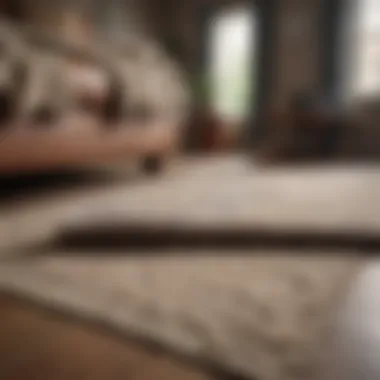
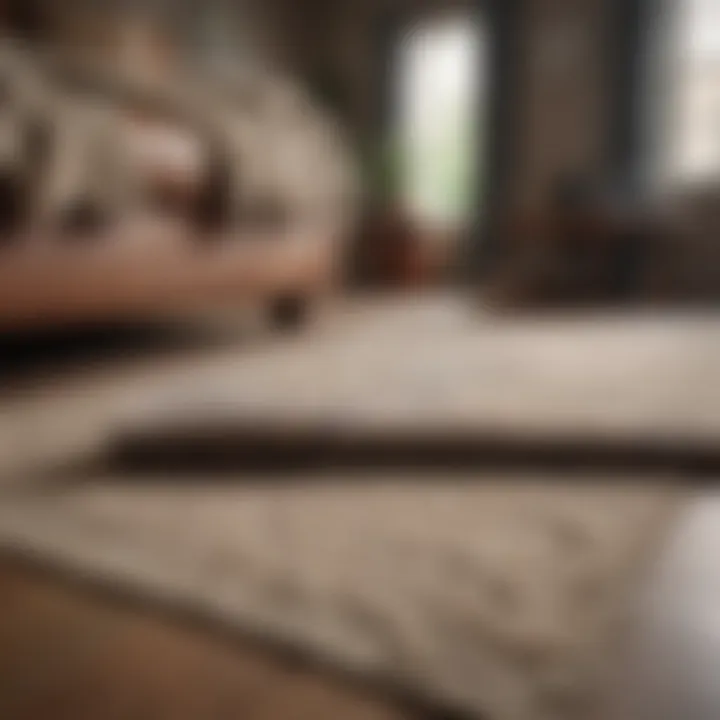
Before you start deep cleaning, it is essential to prepare the rug properly. First, remove the rug from its usual location to avoid any damage to the underlying flooring during the cleaning process. Shake the rug vigorously to dislodge any loose dirt and debris. If the rug is large and heavy, consider using a vacuum cleaner with a nozzle attachment to reach all corners effectively.
Next, check for specific care instructions from the manufacturer. This will guide you on any precautions needed to prevent damage during washing. Always inspect for existing stains, rips, or fraying at the edges; addressing these before cleaning can enhance the effectiveness of your deep cleaning efforts.
Washing Techniques
There are different techniques to wash a wool throw rug thoroughly, depending on its size and the extent of dirt buildup.
- Hand Washing: This method is recommended for delicate wool rugs. Fill a large basin or tub with cool or lukewarm water and add a wool-safe detergent. Submerge the rug gently, ensuring the water penetrates all the fibers. Avoid vigorous scrubbing, as this can cause the rug to felt. Instead, use your hands to gently agitate the water and lift dirt from the fibers. Rinse thoroughly with clean water to remove any soap residue.
- Machine Washing: If the rug is machine washable, place it in a front-loading washing machine. Use a wool-safe detergent and set the machine on a gentle cycle with cold water. Avoid using fabric softeners as they can damage wool fibers. Remove the rug promptly at the end of the cycle to prevent creasing and set it flat on a clean surface to dry.
- Steam Cleaning: This method is effective for deeper cleaning but requires a steam cleaner with appropriate attachments. Follow the manufacturer's instructions carefully. Be cautious with the heat settings, as excessive heat can harm wool fibers.
Select the method that best fits the rug's construction and cleaning requirement.
Drying Methods
Proper drying is as essential as cleaning. Mishandled drying can lead to warp, shrinkage, or further staining. Here are a few methods to ensure suitable drying:
- Air Drying: After washing, lay the rug flat on a clean surface or over a drying rack. Ensure it is away from direct sunlight to prevent fading. Rotate it occasionally for even drying.
- Hanging: For smaller rugs, you may hang it to dry. Use a sturdy clothesline or towel rack, being cautious not to stretch the fabric.
- Avoid Dryers: Do not use a tumble dryer as the heat can be damaging. Wool fibers may shrink and lose their natural shape due to high temperatures.
- Check for Moisture: Once dried, inspect the rug for any remaining dampness before placing it back to avoid mold and musty odors.
By following these steps, deep cleaning your wool throw rug can rejuvenate its look and feel, retaining its beauty for years to come. Remember, keeping a consistent cleaning routine can also aid in managing dirt and stains before they become problematic.
Addressing Common Issues
In the journey of maintaining wool throw rugs, addressing common issues plays a pivotal role. Wool, while being a durable and luxurious material, is not impervious to problems that can arise with normal use. By understanding and resolving these issues, owners can significantly extend the life of their rugs and preserve their appearance.
Dealing with Shrinkage
Shrinkage is a frequent concern for many wool rug owners. It typically occurs when rugs are subjected to moisture without proper drying techniques. Wool fibers can contract if wet rugs are placed in high-temperature environments or washed improperly. To address this issue, a few practices can be implemented:
- Prevention: Always follow cleaning instructions closely to ensure minimal shrinkage occurs.
- Washing: When washing wool rugs, use cold water and avoid wringing out the material, as this can lead to further shrinkage.
- Drying: Lay the wet rug flat on a dry surface, away from direct sunlight or heat sources, to allow it to air dry.
Handling shrinkage effectively involves both preventive measures and correct methods of washing and drying.
Managing Color Bleeding
Color bleeding is another concern that can mar the beauty of wool rugs. This typically occurs during washing or when a rug is exposed to moisture. Understanding the factors that contribute to color bleeding can help mitigate this issue:
- Testing: Always conduct a colorfastness test on a small, hidden area of the rug before any cleaning process, especially when using new cleaning agents.
- Cold Water Use: When washing, always opt for cold water as it tends to prevent colors from running, thus preserving the integrity of the design.
- Avoid Mixing: If there are multiple rugs to clean, make sure not to wash them together unless they are of similar colors.
Proper management of color bleeding helps ensure that the original shades and patterns of the rug remain vibrant.
Removal of Odors
Odors in wool rugs can stem from various sources like food spills, pet accidents, or general buildup of dirt and dust. Effectively removing these odors is essential for a fresh living environment. Here are some strategies:
- Regular Cleaning: Frequent vacuuming is crucial. This removes dust and debris that can contribute to odors.
- Baking Soda: Sprinkling baking soda on the rug and letting it sit for a few hours before vacuuming can help absorb unpleasant smells.
- Vinegar Solution: A mixture of white vinegar and water can be lightly misted onto the surface of the carpet to neutralize essences. Make sure to test this on a small area first to avoid any adverse reactions.
By promptly addressing odors, you can enhance the ambiance of your space and quality of life by ensuring that your wool rug remains not only visually appealing but also odor-free.
Maintaining Wool Throw Rugs
Caring for wool throw rugs is essential to preserve their beauty and functionality. This section discusses key maintenance practices that ensure your rug remains in excellent condition. Regular maintenance not only enhances the rug’s lifespan but also maintains its aesthetic appeal and comfort in your living space.
Regular Vacuuming Schedule
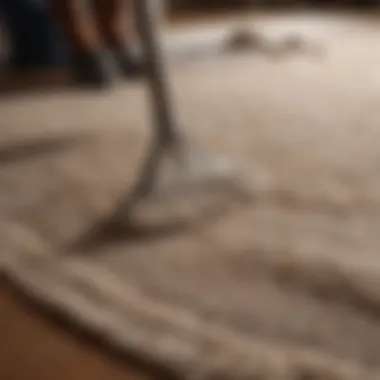
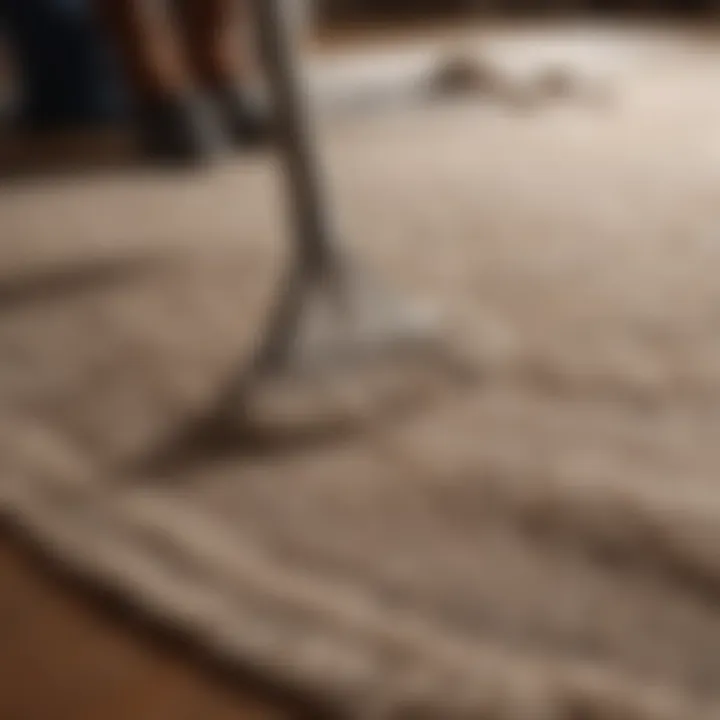
Vacuuming your wool throw rug should be part of a regular cleaning routine. The primary purpose of vacuuming is to remove dirt, dust, and pet hair that can accumulate over time. Wool fibers are naturally resilient, but trapped debris can lead to matting and wear.
To maintain your rug effectively, consider vacuuming at least once a week. Use a vacuum cleaner with a gentle setting to prevent damage. Avoid using a beater bar or rotating brush, as they can harm the delicate fibers. Instead, choose a vacuum head designed for wool or a simple suction-only attachment. This method prevents pulling on the fibers while ensuring a thorough clean.
Rotating for Even Wear
Another important aspect of maintaining wool throw rugs is rotating them regularly. Foot traffic can cause uneven wear over time, leading to certain areas looking more worn than others. Rotating your rug every few months helps distribute this wear evenly across its surface.
When you rotate the rug, consider the direction of the light in the room. If one side is exposed to more sunlight, it may fade faster. By changing the orientation, you can help maintain a consistent appearance and prolong the life of the rug.
Using a Rug Pad
Investing in a quality rug pad is an effective strategy for maintaining your wool throw rug. A rug pad provides cushioning and helps prevent slipping, which can lead to wear in high-traffic areas.
Additionally, using a rug pad absorbs some impact and pressure from foot traffic. This feature protects the rug fibers and enhances comfort underfoot. Make sure to choose a pad that is safe for wool and does not contain any harsh chemicals that could harm the material over time.
Remember that regular maintenance contributes significantly to the longevity of your wool rug. Simple steps like vacuuming, rotating, and using a rug pad can make a profound difference.
When to Seek Professional Help
Cleaning a wool throw rug comes with its challenges. While many stains can be managed at home, there are certain situations where professional intervention is necessary. Understanding when to seek help can save both the rug and your sanity. This section highlights the key elements to consider when deciding if professional cleaning is the right choice for your rug.
Identifying Severe Stains
Sometimes, stains penetrate deep into the fibers of the rug, becoming stubborn and resistant to standard cleaning methods. Severe stains include those caused by red wine, ink, or pet accidents. These types of stains may require specialized treatments. If you try to remove such stains without proper knowledge, it can actually worsen the situation.
Observe the stain carefully. If it does not respond to your initial cleaning attempts or if it spreads, it is a strong indication that you need professional help. Experts have access to high-quality stain removers and techniques that are not available for household use. They can assess the fiber type and the best treatment options.
Evaluating Damage Extent
It's important to assess the overall condition of the rug before proceeding with any cleaning. Look for signs of wear, fading, or fraying edges. If the rug shows significant damage, cleaning at home might not be the best approach. Washing a heavily worn rug can lead to further deterioration.
Some signs to watch for include:
- Loose or missing fibers
- Unraveling threads
- Areas that feel thin or brittle
If you notice these signs, a professional inspection is advisable. They can evaluate damage extent and provide a cleaning method suitable for preserving the rug.
Finding a Specialist
When you decide to hire a professional cleaner, finding a reputable specialist is key. Research local cleaning services that specialize in wool rugs. Look for positive reviews and verify their qualifications.
Questions to consider when finding a professional include:
- Do they have experience with wool rugs?
- What specific cleaning techniques do they use?
- Are they insured and bonded?
Your rug is an investment, and finding the right specialist can ensure it receives the care it deserves. If in doubt, asking for recommendations from friends or checking resources like Reddit or Facebook groups dedicated to interior design can also be beneficial.
Remember: Seeking professional help for your wool throw rug not only preserves its beauty but also extends its life. The right expert can make a significant difference in maintaining its quality.
Ending
Cleaning a wool throw rug is more than just a chore; it is an essential practice that safeguards the investment in quality materials while promoting longevity and aesthetic charm. Throughout this article, we have explored various aspects of cleaning wool throw rugs, illuminating the significance of both regular maintenance and deep cleaning techniques.
Summary of Key Points
- Wool Throw Rugs: Understanding their unique composition and benefits emphasizes the need for careful cleaning practices.
- Regular Cleaning: Regular vacuuming and maintenance prevent dirt accumulation, which can degrade fibers over time.
- Cleaning Tools: Using the right tools, such as a vacuum cleaner, soft brush, and wool-safe detergent, is crucial for effective cleaning.
- Spot Cleaning: Proper techniques for identifying and managing stains can mitigate long-term damage.
- Deep Cleaning: Knowing the appropriate washing and drying methods preserves the integrity of the rug.
- Common Issues: Addressing problems like shrinking and color bleeding can save a rug from irreversible damage.
- Professional Help: Recognizing when to seek help ensures that severe issues are handled correctly.
Final Thoughts on Maintenance
Maintenance of wool throw rugs should be viewed as an ongoing commitment to preserving beauty and function within a home. Regular practices such as vacuuming and using a rug pad can significantly enhance durability.
Furthermore, planning a cleaning schedule based on usage can help highlight any needed attention while keeping the rug in optimal condition.
"A well-maintained rug enhances the overall character and warmth of a space."







